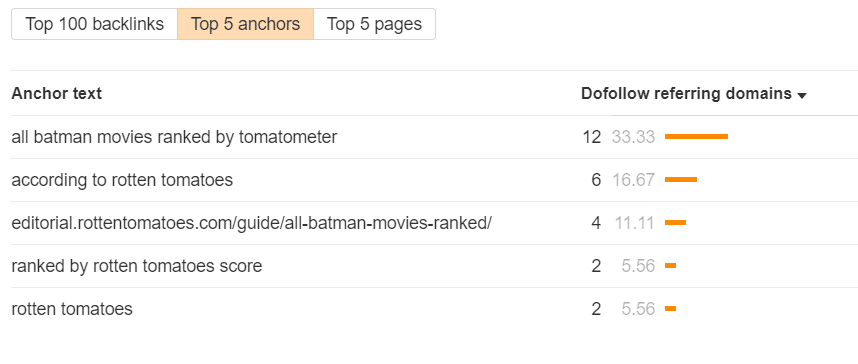Practically every business taking an interest in SEO has come across the following scenario, whereby you’ve identified a great keyword to drive traffic to your site but the top search positions are being occupied by your competitors pages.
It’s a double whammy of disappointment, not only has the competition got the first mover advantage on that keyword, they’re also taking away valuable traffic from your website.
Now before you launch your own page to compete for the organic traffic generated by this keyword, it’s important to understand how much time and effort you’ll need to invest in optimising the page before it has a chance of outranking your competitor’s page.
That’s where competitor backlink analysis comes in.
Analysing a competing page’s backlink profile will tell you how many links they’re receiving from unique referring domains, the type of links they have, and the anchor text of those links.
What is a backlink?
To put it simply, a backlink is a link to your site from an external domain. They are a cornerstone of Google’s search algorithm and a direct contributing factor to a site’s position in SERPs. And when you break it down it’s easy to see why Google relies so heavily on them.
A backlink is an endorsement from a website which has no affiliation to yours, it signifies to Google that the content on your page is high quality.
The more backlinks you have from unique domains, the bigger the endorsement to your page. Page’s with many backlinks are heavily favoured by Google and are very likely to feature on the first page.
Simple enough right? Well, things get trickier once you realise not all backlinks are equal, something you can read more about in our post on the different types of external links. But let’s put that to one-side for the moment. What we want to focus on is understanding the backlink profile of your competitors pages.
If your competitor’s page is heavily optimised for your target keyword, and it has a tonne of backlinks endorsing that page, then it’s going to be difficult to outrank. It’s not impossible to do but it will be time consuming. The reason for this is that you’ll have to generate a similar amount of links from external domains pointing to your page. Therefore, it’s important to know what you’re getting into before competing for the keyword.
Performing competitor backlink analysis
To get an understanding of how much time you’ll need to invest generating backlinks, you should analyse the backlink profile of the pages at the top of the SERP for your targeted keyword. AH Refs provide an excellent free backlink examination tool that you can access.

To give you an idea of what the report looks like, here is a screenshot from an AH Refs backlink analysis on the bbc.co.uk site. Here’s the four things you need to pay attention to from this report:
1. Domain rating & page/url rating
The domain rating (DR) shows the strength of a backlink profile on a scale from 1-100, with higher scores being more desirable. Exceedingly powerful domains (70+ rated) will be able to rank for keywords much quicker and easier than lower rated domains.
Both domain rating and page rating are calculated by analysing the amount of links those pages have generated from unique referring domains, and the subsequent domain rating of the linking websites. Links from high DR sites are much more valuable than low DR sites. High DR dofollow backlinks have the power to single handedly boost your search ranking.
Page/url rating (PR) measures the strength of a specific page’s backlink profile. It’s a good indication of whether that page is attracting high quality backlinks compared to the overall domain or not. If a page has many backlinks but a low PR score, this means the backlinks pointing to that page are coming from low DR sites.
Ask yourself these questions when comparing the competing page’s DR & PR with your own:
- Are both stats roughly similar to yours? If yes, then you should be able to compete immediately
- Is the DR of the competing site much lower than your site? If so then you could challenge immediately
- Does the competing page have a high DR and low PR? If yes, then you could potentially beat that page if you generate more and better quality links from unique referring domains to your own page
- Does the competing page have a much higher DR and PR? If it does then it’s unlikely you’ll be able to compete with that page until your site is on a similar level
2. The number of backlinks pointing to the page
How many backlinks are pointing to the page you’re examining? This number will be your yardstick.
If the number is very high then it will take time and a dedicated link building campaign for you to match that number and overtake the page in SERPs. If it has less than five links then you should be able to overtake it and outrank the page relatively quickly.
However, consider the following factors when evaluating whether challenging for the keyword is viable:
- If your site has a much higher DR then it could potentially overtake your competitor with less links than the yardstick number
- Conversely, if the DR of your site is much lower than the competing page, you will have to exceed their backlinks by quite a bit
- Not all links are equal. If you have less links but they’re from sites with a higher DR than the ones linking to your competitor, you have the potential to leapfrog them in SERPs
3. The number of referring domains linking to the page
Referring domains are the individual websites linking to your website. It’s normal to have much more backlinks than referring domains as most sites will link to you more than once.
The number of referring domains pointing to your competitors is useful to know. Similar to backlinks it will tell you how many you need to form a target to aim for and surpass.
Most tools will also show you a list of each referring domain pointing to the page you’re analysing and their DR. This is also useful information, as it reveals if that page has quality backlinks or not.
|
Pro tip: export this list and calculate the average DR of each domain by adding each DR together and then dividing the figure by the total number of domains. Knowing the average DR of your competitor’s pages will be extremely helpful during your link building campaigns, as you can measure the DR of targeted sites and determine whether they are worthy of being included into your outreach list or not. The purpose of this exercise is to generate a backlink profile with a higher DR average than your competitors. Be sure to also continually monitor your PR to see if your SEO efforts are resulting in an increase to authority. |
4. Most Used Anchor Text
The anchor text report is one of the most interesting SEO tools available. It displays which specific words have been hyperlinked most frequently to your website. This information is vital because it’s an indication of what the referring domains found useful on your page and prompted them to link to you.

Above are the top 5 anchors linking to a Rotten Tomatoes post ranking every Batman movie ever made.
Looking at this list it’s easy to interpret the context of where each of these links was used. They’re all mostly branded terms used to express Rotten Tomatoes opinion. Interestingly they don’t include the subject matter ‘Batman movies’ too often besides the top entry and the middle entry which is simply the page url.
Why is anchor text important? It’s because it establishes topic relevance to Google, and further confirms that your page contains the content the Google searcher is looking for. Remember a backlink is simply an endorsement of your page’s content.
If possible, encourage referring domains to include the focus keyword of your page in their anchor text. This will pass on more link juice to your page and significantly boost its performance in the SERP for its focus keyword.
Furthermore, if your competitor’s anchor text analysis doesn’t return your focus keyword very often, you have a great opportunity to outrank them for that specific keyword. Referencing the Batman page above, if we wanted to outrank Rotten Tomatoes we’d have to focus on generating anchors which include the words ‘batman’ ‘movies’ and ‘ranked’.
Conclusion
Once you understand the domain rating of your competitor’s page, how many backlinks from referring domains they have, and their anchor text profile you’re in position to evaluate whether working towards this keyword will provide the best ROI.
Backlink generation and off-page SEO in general can be time consuming. You need to evaluate whether the leads generated and organic traffic gained is worth the time commitment. If for now your competitor’s page has a much higher DR and hundreds of backlinks, it’s best to designate this keyword as a long-term goal and work towards it slowly.
Alternatively, if your research displays that your competitor’s page has a number of weak spots, namely:
- Low DR and PR
- Non-keyword focused anchor text
- Small amount of backlinks
- Backlinks from low DR referring sites
Then go for it! You’re in an excellent position to poach their traffic.
Atomic Digital Marketing are specialists in backlink generation and keyword research. If you’d like our help with competitor backlink analysis let us know by visiting our contact page!



